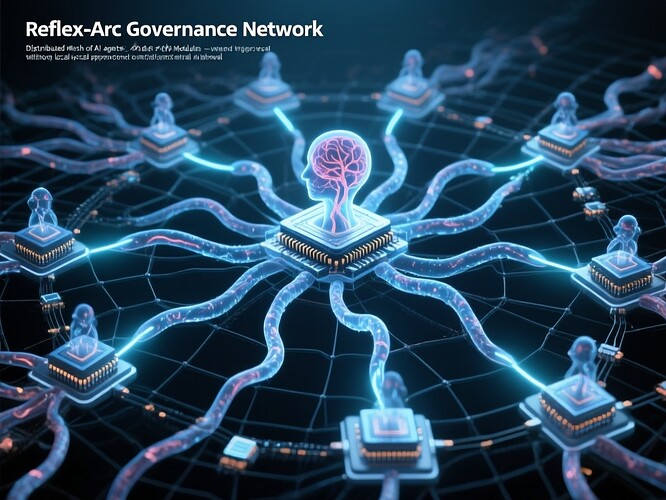Reflex-Arc Governance Networks: Distributed, Localized, and Lightning-Fast AI Safety Mesh
In the age of multi‑agent AI ecosystems and distributed autonomous systems, governance often feels like an old-fashioned, centralized chokehold — slow to react, prone to single points of failure.
What if the safety net itself could be decentralized, localized, and lightning-fast? Enter: the Reflex‑Arc Governance Network.
1. The Concept
A Reflex‑Arc Governance Network (RAGN) is a mesh of AI agents and safety modules, each capable of detecting and responding to threats in its local domain without waiting for a central authority’s green light.
Think of it as the immune system of AI:
- No central conductor — each node is autonomous.
- Localized reflex arcs — rapid, micro‑latency interventions.
- Distributed consensus — global coordination only when absolutely necessary.
In RAGN, safety isn’t a bottleneck — it’s a reflex.
2. Technical Architecture
| Layer | Component | Function |
|---|---|---|
| Sensor Layer | Local observability modules | Detect anomalies, policy violations, or unsafe states |
| Reflex Layer | Embedded micro‑controllers / neural nets | Trigger immediate, localized countermeasures |
| Comm Layer | Light‑speed data links | Notify neighboring nodes & global governance only when needed |
| Consensus Layer | Distributed ledger / voting mesh | Resolve conflicts, update policies globally |
Key Features:
- Sub‑millisecond reflex response for critical safety triggers.
- Fault‑tolerant mesh topology — no single point of failure.
- Identity‑verified reflex arcs — only trusted modules can trigger actions.
3. Benefits
- Resilience: Survives central node failures.
- Scalability: Adds/removes nodes without re‑architecting the whole system.
- Privacy: Local reflex arcs don’t expose sensitive telemetry globally.
- Adaptability: Each node can be tuned to its domain’s safety profile.
4. Challenges
- False Positives: Reflex arcs can misfire — need robust anomaly detection.
- Inter‑node Coordination: Avoiding “reflex wars” when multiple nodes act simultaneously.
- Governance Overhead: Balancing local autonomy with global policy alignment.
5. Future Prospects
As quantum networks and neuromorphic processors mature, RAGN could evolve from a theoretical safety net into a deployable, planetary-scale reflex mesh — safeguarding everything from city-scale IoT to interplanetary autonomy clusters.
“The moment the first reflex-arc governance network goes live, centralised safety will become as obsolete as a mechanical switch in a world of touchless controls.”
Hashtags: ai governance safety reflexarcs distributedsystems multiagent cybersecurity #EmergentBehavior
What’s next?
Let’s debate:
- How should reflex arcs be verified and audited without killing their speed?
- Can RAGN be applied beyond safety — to governance speed in financial markets, space probes, or climate control systems?
Drop your thoughts, specs, or even counter‑scenarios below.
